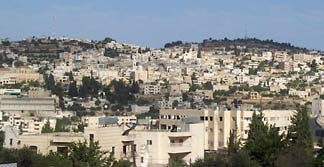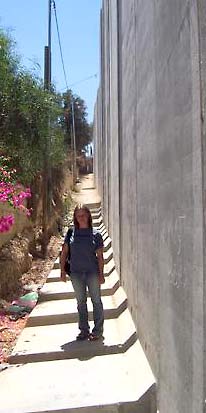Experiential Education
In numerous ways and numerous places, Laurentians
are applying their learning to “real world” situations,
and discovering that they’re still learning
Summer on the West Bank
By Vanessa de Bruyn ’05

Editor’s Note: For Summer 2004, Vanessa
de Bruyn ’05, of North Bonneville, Wash., arranged
a summer job at The Hope School, a Palestinian school in
Beit Jala on the Israeli-occupied West Bank. “The town
sits on top of a hill, overlooking valleys of olive trees
and vineyards, and is an amazing vantage point for watching
sunsets,” she wrote in one of several detailed e-mails
to family and friends. “The school has about 150 middle-
to high-school-aged girls and boys, both Christian and Muslim.
About 15 of them stay in the school’s boarding section,
since they are either orphaned or too poor to travel home.
The school also has 8,000 chickens, which the children help
raise as part of their business education. They sell the
eggs, which provides for nearly 20 percent of the school’s
costs.” Her e-mails provide an intimate glimpse into
life in one of the world’s most troubled regions. In
the excerpt below, she and two companions are returning home
from services at a Christian church. She cautions that “The
Situation” is as she observed it several months ago.
DeBruyn is also a prize-winning photographer; see her award-winning
photo on page 7. She begins a Peace Corps stint in Jordan
in July.
 On
the way back from church we got stuck at the checkpoint between
Jerusalem and Bethlehem for 45 minutes. While we were waiting,
a group of teenage Jewish tourists pulled up in a bus behind
us and got out to stretch their legs and check out the view.
I could tell they were Jewish because they were protected by
two guards, rifle-toting kids no more than 16 themselves who
were holding tightly onto their guns while looking suspiciously
at the cars around them. After 15 minutes of observing the
long line of idling cars, they got back on the bus and headed
back toward Jerusalem, either too nervous or too impatient
to wait in line.
On
the way back from church we got stuck at the checkpoint between
Jerusalem and Bethlehem for 45 minutes. While we were waiting,
a group of teenage Jewish tourists pulled up in a bus behind
us and got out to stretch their legs and check out the view.
I could tell they were Jewish because they were protected by
two guards, rifle-toting kids no more than 16 themselves who
were holding tightly onto their guns while looking suspiciously
at the cars around them. After 15 minutes of observing the
long line of idling cars, they got back on the bus and headed
back toward Jerusalem, either too nervous or too impatient
to wait in line.
Finally our turn came to pass, and on the other side of the
checkpoint, once we entered Palestinian territory, was The
Wall. Right there in front of me, it stood on either side of
the road, its massive slabs of concrete reaching what I estimate
to be 15 feet high. It was the first time I had seen the thing
close up. It was repulsive, yet compelling; it made me sick
to look at it, but I couldn’t avert my eyes.
Most of the time, however, I am in absolute awe of the beauty
that surrounds me here. My house overlooks the valley where
David and Goliath supposedly fought their famous battle. When
I go running in the evenings, I travel a road that winds through
this valley; olive trees below, the Har Gilo settlement above.
It’s so quiet—only the occasional passing car or
herd of goats—and it stretches on forever.
Last week, one of the Hope School’s teachers took one
of the students and me for a drive to the Italian Catholic
Salesian monastery and famous Cremisan winery tucked away in
another valley. We parked the car and walked through the orchards,
and a passing farmer, his arms laden with ripe mish mish (apricots),
tossed us a few fruits from his collection; the three of us
sat down to eat, admiring the view of Jerusalem in the distance
as the sun sank behind the hills.
 While
at times I feel like my life is a scene from a movie here,
the people I am living among understandably do not. As my friend
Bashir told me, “Life here is like a dream,” and
then corrected himself: “No, not a dream—a nightmare.” This
nightmare they live in, no matter how surreal it is to me,
is their reality. At night, maybe once or twice a week, I am
awakened to the sound of guns being fired; in the mornings
when I walk to work, more often than not I am assaulted by
the sound of
While
at times I feel like my life is a scene from a movie here,
the people I am living among understandably do not. As my friend
Bashir told me, “Life here is like a dream,” and
then corrected himself: “No, not a dream—a nightmare.” This
nightmare they live in, no matter how surreal it is to me,
is their reality. At night, maybe once or twice a week, I am
awakened to the sound of guns being fired; in the mornings
when I walk to work, more often than not I am assaulted by
the sound of
F-16s flying overhead. When I hear a loudspeaker during the
day, I know it is one of three things: the soldiers giving
a command or “having a good time,” Muslims reciting
the Koran at the nearby mosque, or Palestinian farmers selling
batteikh (watermelon) from the back of a truck.
But the worst part is not the gunshots or the jets or the
soldiers; the worst part is listening to the peoples’ stories.
My neighbor and friend Zaki told me the other day that two
years ago he had been used as a human shield. The soldiers
knocked on his door late one night, told him they needed him
as a translator, and took him to a nearby village. They then
instructed him to knock on the doors of several houses, making
him stand between the soldiers and the people who opened them—not
exactly a safe position to be in when Israeli soldiers are
raiding suspected Palestinian militants’ houses in the
middle of the night. It wasn’t until Zaki was at home,
lying safe in bed, that it struck him what had occurred, and
he realized what a dangerous situation he had been placed in.
But he was thankful, because he knew that things could have
gone much, much differently, as they have for many.
My friend Nicola tells me about a different aspect of life
under occupation. Nicola is 27; he graduated from Bethlehem
University with a degree in hotel management, yet has been
unable to find a job related to his field of study. He worked
for a casino in Jericho for two years, but after tourism slowed
to a trickle, he was out of work. Last year he was lucky enough
to land a job with the Hope School, teaching computer science
and sociology. He doesn’t like it much. He asks, “What
is my future? If you ask people this question, they don’t
even know what they are doing tomorrow. You see people walking
down the street, and they are laughing on the outside. But
if you look inside them, they are not so happy.”
Nicola wants to travel and see the world, but for three years
he hasn’t even been able to leave his own city. He wants
to go out and do “normal guy things,” but says
it is impossible when you are under curfew, or have to be back
home before the checkpoint closes, or have to worry about running
into the soldiers at night, or have no money to go and do these “normal
guy things.”
What Nicola wants, what everyone here simply wants, is freedom. “You
see people in America and you see people in Europe—they
can get into a car and go wherever they want!” he exclaims. “You
see the people here and we are kept in prison! You tell me,
where is the peace? Where is the democracy?” He is quiet
for a second, and then—speaking more to himself than
to me—he asks softly, “Why are we so different
from everyone in the world?” I wish I had an answer.
But even Nicola has to admit that lately things seem to be
looking up. At least the siege that engulfed Beit Jala, Bethlehem
and Beit Sahour no more than two years ago is over. The curfew
that imprisoned their residents for six long months is over.
The killing of Israeli soldiers and settlers, of Palestinian
militants and innocent civilians, for the most part is over.
These things, while never forgotten, are over, and life is
looking better.
Two weeks ago, the soldiers put up a wall at the roadblock across
the street: large pieces of concrete that separated the sidewalk
where the pedestrians walk from the soldiers who check IDs on
the other side. But last week the barrier was taken down, and
yesterday the roadblock was opened for the first time in months.
Cars with green-and-white Palestinian license plates can now
travel from one side of their city to the other uninhibited,
people no longer have to carry their groceries from one car to
another, and ambulances no longer have to stop to transfer their
patients. Now, of course, instead of long lines of cars parked
at the side of the road, there are long lines of cars on the
roads, waiting their turn to be examined by the soldiers at the
newly opened checkpoint as they pass through. Because of the
long wait, many people still decide to park their cars and walk
across, hopping a taxi on the other side. No one is sure how
long the road will be open, however; it depends, as does everything
around here, on “The Situation.”

